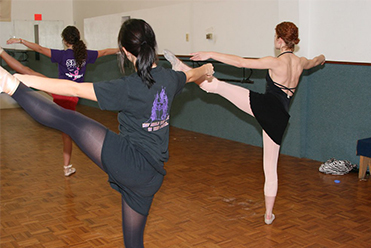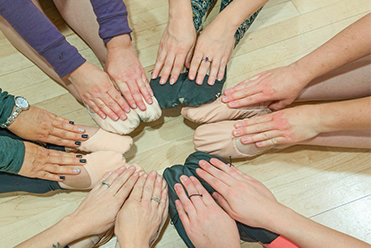
By grown-up standards, children pursue creative risks like music, art or dance with tremendous bravery and abandon. The reality is kids take amazing leaps because it never occurs to them they should not. To be self-conscious over one’s efforts at creative self-expression is a learned trait and one we find very difficult to shed as we age. Last summer many grown-ups were heartened when the international dance community rallied around 6-year old Prince George after ABC Good Morning America host Lara Spencer poked fun at the little boy’s fondness for his ballet class. Spencer publicly apologized for her comments, but there was no getting past how the little prince’s confession invited a great many adults to dance.
CE Beginning Ballet for Adults instructor Bri Wilson shares Prince George’s love of dance, and years ago found inspiration in another little boy’s bravery and abandon. “When I was seven, my brother started taking ballet classes,” she recalls. “My mom and I would wait for him in the hallway outside of the dance studio, and I would imagine what movement was springing to life behind the studio’s heavy oak door. I thought ballet meant rolling around on the floor, and I wanted to try it too!”
Wilson says when she finally had the opportunity to join a dance class, she discovered she had to push past the stories dictated by her imagination. “I was surprised to learn in my first class that ballet required standing up, first holding on to a wooden stick and then floating, turning, and jumping across the floor,” she says. “I immediately fell in love with expression through movement; I was beginning to discover the body’s capacity for storytelling, and I hungered to learn how to speak and listen.”
By age twelve, Wilson had graduated to dancing en pointe, a milestone for any ballet student. “I could now wear the shoes that professional ballerinas wore too. This was my first enormous step towards becoming a professional dancer, and as I slipped on my pointe shoes for the first time, I knew that I wanted to dance forever,” she recalls. “As my training progressed, I discovered a profound love for contemporary movement.”
Wilson’s love of movement would eventually lead her to the LINES Ballet Summer Program. “I dove deep into contemporary dance and improvisation practices,” she says. “I returned home with a new focus on discovering all the ways my body could possibly move, and I have followed that investigation to the LINES BFA Program, where I graduated with a BFA in Dance in May 2018.”
It does not take long to discover Wilson is an instructor who views dance and teaching as interconnected art forms. As her creative life has expanded, so did her facility for teaching. “In 2017 I attended Movement Invention Project in New York City, an intensive process designed to provide ample opportunities for exploration without product,” says Wilson. “There I reconnected to my body and love for dance in ways I had not thought possible; I was overwhelmed with a sense of wonder and gratitude for my body, and felt incredible surrender, vulnerability and power inside my movement. That experience helped me realize that I want to help people to feel at home in their bodies, and for me, teaching is the most effective and most joyous way to do that.”
Though many forms of dance inspire Wilson, improvisation resonates with her most deeply. “I believe that all forms of dance, in some way or another, help dancers build an intricate understanding and awareness of their bodies,” she says. “In improvisation, we develop that awareness through an infinite field of movement. In ballet, we develop that awareness through one slice of that field. We gather just as much valuable information by walking through that slice as we do the whole field.”
Considering that ballet and improvisational dance are widely different dance forms, Wilson’s fascination with both speaks volumes about her flexibility as an artist and teacher. “Dance improvisation feels like falling into a rushing river: I let the wisdom, habits, and intelligence of my body carry me into movement,” she says. “Ballet, however, is highly structured, regimented, and repetitive. There is a distinct order to each class. Improvisation takes any form at any time, and can use rules to fuel creativity and ingenuity. If improvisation is abstract painting, then ballet is expressionism.”
 In teaching Beginning Ballet for Adults Wilson seeks to establish a safe environment for those who considered exploring dance in the past but might have felt discouraged or deflected. The class is open to all, from those with some prior experience, to those seeking to explore ballet for the first time. “We’ll move through a beginning-level ballet class with just enough detail to support learning the choreography,” Wilson says. “We won’t dive in to advanced anatomy or energetic pathways quite yet.”
In teaching Beginning Ballet for Adults Wilson seeks to establish a safe environment for those who considered exploring dance in the past but might have felt discouraged or deflected. The class is open to all, from those with some prior experience, to those seeking to explore ballet for the first time. “We’ll move through a beginning-level ballet class with just enough detail to support learning the choreography,” Wilson says. “We won’t dive in to advanced anatomy or energetic pathways quite yet.”
Wilson cannot help but be energized by a student’s learning process. “I enjoy watching students figure out how to work the steps in their own bodies,” she says. “I love watching bodies think and learning ballet choreography is exactly that. There is so much joy for me in watching students tackle challenging steps until the movement is ingrained in their muscle memory; the process holds so much beauty in the perseverance.”
More than anything, Beginning Ballet for Adults will be a supportive place for a student to connect to their body’s ability for creative expression. “Students can look forward to finding a community through dance and building a deeper awareness of their bodies,” says Wilson. “I look forward to students leaving Beginning Ballet for Adults with a little bit more of a comprehensive understanding of their bodies, some ideas for a continued movement practice, and hopefully many memories of fun and joy.”
Photo credits